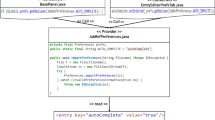Abstract
Software configuration management (SCM) is an important key technology in software development. Component-based software development (CBSD) is an emerging paradigm in software development. However, to apply CBSD effectively in real world practice, supporting SCM in CBSD needs to be further investigated. In this paper, the objects that need to be managed in CBSD is analyzed and a component-based SCM model is presented. In this model, components, as the integral logical constituents in a system, are managed as the basic configuration items in SCM, and the relationships between/among components are defined and maintained. Based on this model, a configuration management system is implemented.
Similar content being viewed by others
References
Burrows C, George G, Dart S. Configuration Management. Ovum Ltd., 1996.
Rational Corporation, Clear Case Concepts Manual. Document Number 800-010043-000, January, 1998.
McCabe & Associates Corporation, McCabe TRUEChange, Available WWW 〈URL: http://www.mccabe.com/products/truechange.htm〉 (2000)
Merant Corporation, PVCS Product, Available WWW 〈URL: http://www.merant.com/products/pvcs/〉 (2000)
Microsoft Corporation, Visual SourceSafe Technical Articles, Available WWW 〈URL: http://msdn.microsoft.com/ssafe/technical/articles.asp〉 (2000)
Aoyama M. Component-based software engineering: Can it change the way of software development? InProceedings of the International Conference on Software Engineering, Volume II, April, 1998, pp.111–120.
Christensen H B. Experiences with architectural software configuration management in Ragnarok. InProceedings of the Eighth International Symposium on System Configuration Management, Brussels, Belgium, July, 1998, pp.50–56.
A van der Hoek, Heimbigner D, Wolf A L. System modeling resurrected. InProceedings of the Eighth International Symposium on System Configuration Management, Brussels, Belgium, July, 1998, pp.124–130.
Leblang D B, McLean D G. Configuration management for large-scale software development efforts. InGTE Workshop on Software Engineering Environments for Programming in the Large, June, 1985, pp. 122–127.
Estublier J. A configuration manager: The Adele data base of programs. InProceedings of the Workshop on Software Engineering Environments for Programming-in-the-Large, June, 1985, pp. 140–147.
Sommerville I, Dean G. PCL: A language for modeling evolving, system architectures.Software Engineering Journal, 1996, 5(3): 111–121.
Berliner B. CVS II: Parallelizing software development. InProceedings of the Winter 1990 USENIX Conference, January 22–26, 1990, Washington, DC, USA (Berkeley, CA, USA, Jan. 1990), USENIX Association, Ed., USENIX, pp.341–352.
MacDonald J, Hilfinger P N, Semenzato L. PRCS: The project revision control system. InProceedings of the Eighth International Symposium on System Configuration Management, Brussels, Belgium, July, 1998, pp.78–84.
Podgurski A, Clarke L A. A formal model of program dependences and its implications for software testing, debugging and maintenance.IEEE Transactions on Software Engineering, Sept., 1990, 16(9): 965–979.
Moriconi M, Winkler T C. Approximate reasoning about the semantic effects of program changes.IEEE Transactions on Software Engineering, Sept., 1990, 16(9): 980–992.
Borison E. A Model of Software Manufacture. InAdvanced Programming Environments, Conradi R, Didriksen T, Wanvik D (eds.), New York: Springer-Verlag, 1986, pp. 197–200.
Lu Qi. A graph model for software evolution.IEEE Transactions on Software Engineering, Aug., 1990, 16(8): 917–927.
Mei Hong, Zhang Lu, Yang Fuqing. A software configuration management model for supporting component-based software development.ACM SIGSOFT Software Engineering Notes (USA), 2001, 26(2).
Feiler P. Configuration management models in commercial environments. Technical Report CMU/SEI-91-TR-7, Software Engineering Institute, Pittsburgh, Pennsylvania, March, 1991.
Conradi R, Westfechtel B. Version models for software configuration management.,ACM Computing Surveys, June, 1998, 30(2).
Rochkind M J. The source code control system.IEEE Trans. Software Engineering, Dec., 1975, 4(6): 364–370.
Tichy W. RCS — A system for version control.Software Practice and Experience, 1985, 15(7): 637–654.
Habermann N, Notkin D. Gandalf: Software development environments.IEEE Trans. Software Engineering 12, Dec., 1986, 12(11): 1117–1127.
Wakeman L, Jowett J. PCTE — The Standard for Open Repositories. Prentice-Hall, Englewood Cliffs, NJ, 1993.
Reichenberger C. VOODOO — A tool for orthogonal version management. InSoftware Configuration Management: Selected Papers SCM-4 and SCM-5 (Seattle, WA, April), Estublier J (ed.), LNCS 1005, Springer-Verlag, 1995, pp.61–79.
MacKay S A. The state-of-the-art in concurrent, distributed configuration management. InSoftware Configuration Management: Selected papers SCM-4 and SCM-5 (Seattle, WA, April), Estublier J (ed.), LNCS 1005, Springer-Verlag, 1995, pp. 180–184.
Author information
Authors and Affiliations
Corresponding author
Additional information
This paper is supported by the National ‘863’ High-Tech Programme and the National Natural Science Foundation of China under Grant Nos.863-306-ZT02-02-2 and 60043002. It also gets support from the National Excellent Young Scientists Foundation.
MEI Hong is a professor in computer science at Peking University. He received his Ph.D. degree from Shanghai Jiaotong University in 1992. His research interests include software engineering and CASE tool, software reuse, software component technology, and distributed object technology.
YANG Fuqing is a professor in computer science at Peking University and a member of the Chinese Academy of Sciences. She graduated from the Graduate School of Peking University in 1958. Her research interests include operating systems, software engineering, CASE environment, software reuse and objectoriented technology.
Rights and permissions
About this article
Cite this article
Mei, H., Zhang, L. & Yang, F. A component-based software configuration management model and its supporting system. J. Comput. Sci. & Technol. 17, 432–441 (2002). https://doi.org/10.1007/BF02943283
Received:
Revised:
Issue Date:
DOI: https://doi.org/10.1007/BF02943283




